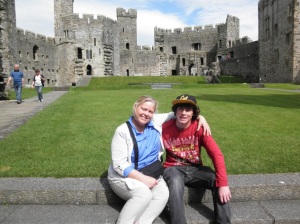On our last day in London we rented a car first thing in the morning and, after a brief stop in Oxford to visit friends, we drove into Wales (on the wrong side of the road!) to begin our 6 day tour of Welsh castles, most of which were built by Edward I, King of England, from 1272 to 1307. Many of these castles, built by Edward I to oppress the Welsh people with the power of English rule, still stand today. These castles are also known for their “Crusader” style architecture utilizing concentric towers and arrowslit windows for defense.


We arrived near the town of Tongwynlais, just north of Cardiff, and checked into the B & B we would stay at for a couple of days. Our place was really cool, complete with an English garden in back and sheep and horses in front. We could see our first castle, Castle Coch, off in the distance, up on the side of a steep hill.
Castle Coch known as the Red Castle, is a 19th-century Gothic Revival castle and is built on the remains of a genuine 13th-century fortification. In 1871, John Crichton-Stuart, 3rd Marquess of Bute, and a wealthy coal mine owner, ordered his architect to draw up plans for this full reconstruction. Castell Coch was to achieve a “dazzling architectural tour de force of the High Victorian era, a dream-like castle which combined sumptuous Gothic fantasy with timeless fairy tale.” In 1950, the 5th Marquess of Bute placed the Castle in the care of Cadw (the Welsh agency which oversees historical landsites on behalf of the National Assembly for Wales).
Some interesting trivia, Castle Coch has at times, been used as a set for the tv show Dr. Who and also Merlin. The castle has also appeared in numerous movies.
 The next castle on our trip was Caerphilly Castle located in the nearby town of Caerphilly. This castle, built in 1268, is the largest castle in Wales and the second largest in Britain after Windsor Castle. Caerphilliy Castle was not built by Edward I but it did undergo some restoration in the late 1800’s financed by the 3rd Marquess of Bute. This castle was also placed in the care of Cadw by the 5th Marquess of Bute.
The next castle on our trip was Caerphilly Castle located in the nearby town of Caerphilly. This castle, built in 1268, is the largest castle in Wales and the second largest in Britain after Windsor Castle. Caerphilliy Castle was not built by Edward I but it did undergo some restoration in the late 1800’s financed by the 3rd Marquess of Bute. This castle was also placed in the care of Cadw by the 5th Marquess of Bute.
Caerphilly Castle is absolutely awe inspiring with its huge concentric towers, its massive defensive water moats and the proximity of its location next to the picturesque town of Caerphilly. Sean and I had fun “playing” with a replica of a siege engine, or ballista, which was basically a “ginourmous” cross bow with surprisingly easy maneuverability. The main chapel of the castle has been restored inside and is used today for wedding ceremonies. There was one taking place the day we were there. Could you imagine being married in a castle that is over 700 years old?
 Our third day in Wales we visited Saint Fagan’s Natural History Museum in Waunfawr, Gwyneddon. This outdoor museum is a virtual spread of acres and acres of land and is a “hand’s on” history of Welsh life; from prehistoric Celtic structures to present-day coal mining “company” town residences. It is an opportunity for the Welsh people, and others, to see their heritage firsthand. The day we were visiting there were loads of school groups roaming the grounds with us. Many of the structures here are authentic; farmhouses, chapels and others, but in keeping with our desire to see the castles of Wales, we spent most of our time at St Fagan’s Castle, built in 1580, and it’s beautiful gardens. It was donated to the people of Wales by the Earl of Plymouth, and the rest of the outdoor museum is built on the land surrounding the castle.
Our third day in Wales we visited Saint Fagan’s Natural History Museum in Waunfawr, Gwyneddon. This outdoor museum is a virtual spread of acres and acres of land and is a “hand’s on” history of Welsh life; from prehistoric Celtic structures to present-day coal mining “company” town residences. It is an opportunity for the Welsh people, and others, to see their heritage firsthand. The day we were visiting there were loads of school groups roaming the grounds with us. Many of the structures here are authentic; farmhouses, chapels and others, but in keeping with our desire to see the castles of Wales, we spent most of our time at St Fagan’s Castle, built in 1580, and it’s beautiful gardens. It was donated to the people of Wales by the Earl of Plymouth, and the rest of the outdoor museum is built on the land surrounding the castle.
 That afternoon we drove to the seaside town of Aberystwyth to spend the night. Aberystwyth, known to the locals as Aber, is a small college town on the west coast of Wales, facing out towards the Irish Sea. The coastal town is quite beautiful and the local college, Aberystwyth University, looks very much like a huge Victorian mansion. Here we relaxed, ate a traditional Welsh dinner of lamb and then watched the sunset on the sea.
That afternoon we drove to the seaside town of Aberystwyth to spend the night. Aberystwyth, known to the locals as Aber, is a small college town on the west coast of Wales, facing out towards the Irish Sea. The coastal town is quite beautiful and the local college, Aberystwyth University, looks very much like a huge Victorian mansion. Here we relaxed, ate a traditional Welsh dinner of lamb and then watched the sunset on the sea.
 The next morning we were back in the car again headed to Portmeirion, a popular and very whimsical tourist village in Gwynedd, North Wales. Portmeirion has served as the location for numerous films and television shows, most famously serving as “The Village” in the 1960s surreal spy television show The Prisoner. It is a collection of a multitude of architectural styles; some authentic buildings were relocated to the resort, others were built as replicas of historical buildings. There is, of course, a castle on the property, Castell Deudraeth, which is the remains of an actual medieval castle but is now renovated and used as a restaurant.
The next morning we were back in the car again headed to Portmeirion, a popular and very whimsical tourist village in Gwynedd, North Wales. Portmeirion has served as the location for numerous films and television shows, most famously serving as “The Village” in the 1960s surreal spy television show The Prisoner. It is a collection of a multitude of architectural styles; some authentic buildings were relocated to the resort, others were built as replicas of historical buildings. There is, of course, a castle on the property, Castell Deudraeth, which is the remains of an actual medieval castle but is now renovated and used as a restaurant.
 After breakfast at Portmeirion we drove into the Welsh town of Caernarfon, here we would be in close proximity to two very important castles, the first one, Caernarfon Castle, is the actual castle of the Prince of Wales. King Edward’s son, Edward, who later became King Edward II—was born at Caernarfon Castle. In 1301 the young Edward II became the first English prince to be invested with the title of Prince of Wales. Carried to this day, the title is traditionally granted to the heir apparent to the reigning monarch of the Kingdom of England, now known as the United Kingdom of Great Britain and Northern Ireland. The current Prince of Wales is Prince Charles, the eldest son of Queen Elizabeth II.
After breakfast at Portmeirion we drove into the Welsh town of Caernarfon, here we would be in close proximity to two very important castles, the first one, Caernarfon Castle, is the actual castle of the Prince of Wales. King Edward’s son, Edward, who later became King Edward II—was born at Caernarfon Castle. In 1301 the young Edward II became the first English prince to be invested with the title of Prince of Wales. Carried to this day, the title is traditionally granted to the heir apparent to the reigning monarch of the Kingdom of England, now known as the United Kingdom of Great Britain and Northern Ireland. The current Prince of Wales is Prince Charles, the eldest son of Queen Elizabeth II.
 The next major castle for the day, Castle Harlech, is another impressive castle built by Edward I. This castle sits right on the coast and has a water gate with a stone stairway which allowed the castle to be resupplied by sea while under siege.
The next major castle for the day, Castle Harlech, is another impressive castle built by Edward I. This castle sits right on the coast and has a water gate with a stone stairway which allowed the castle to be resupplied by sea while under siege.
 On our last day in Wales we visited two more castles. The first for the day was Conwy Castle, another castle built by Edward I. This castle is also built next to the sea and has an elaborate drawbridge and train tunnel allowing modern day access to the town and surrounding community.
On our last day in Wales we visited two more castles. The first for the day was Conwy Castle, another castle built by Edward I. This castle is also built next to the sea and has an elaborate drawbridge and train tunnel allowing modern day access to the town and surrounding community.
 The last castle for the day, and probably the most beautiful of all the ones we looked at, was Castle Beaumaris. Begun in 1295, it was the last and largest of the castles to be built by King Edward I in Wales. The inner ward of the castle is completely surrounded by the outer ward (the wall) which is completely surrounded by a moat. The castle has a tidal dock, and all entrances are protected by “murder holes” from which substances such as hot oil could be poured over enemy forces. Attackers of Beaumaris Castle would have met 14 separate obstacles and four lines of fortification resulting from the ‘walls within walls’ design. Quite an impressive fortress!
The last castle for the day, and probably the most beautiful of all the ones we looked at, was Castle Beaumaris. Begun in 1295, it was the last and largest of the castles to be built by King Edward I in Wales. The inner ward of the castle is completely surrounded by the outer ward (the wall) which is completely surrounded by a moat. The castle has a tidal dock, and all entrances are protected by “murder holes” from which substances such as hot oil could be poured over enemy forces. Attackers of Beaumaris Castle would have met 14 separate obstacles and four lines of fortification resulting from the ‘walls within walls’ design. Quite an impressive fortress!


sounds like a fun trip!